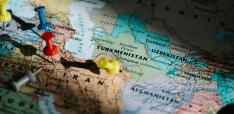Cuts to USAID – the Fallout Continues (Part 3)
In the third and final part of a series on the implications and consequences of the cuts to the U.S. Agency for International Development (USAID), Simon Fraser asks ‘What will be the results of the wider disruption to global development assistance and the multilateral architecture that has historically underpinned it and how will the drastic and dramatic cuts to USAID impact on the United States’ reputation and international development leadership’? (Read Part 1 and Part 2)
Global Development Assistance Gone
The United States has long been the major contributor to global development. So the withdrawal of 90% of USAID development assistance through USAID wrecks the very scaffolding of international development and is felt most acutely where systems are most fragile, the needs acute, and alternative donors few.
The Centre for Global Development highlights that the largest USAID cuts by sector are in Protection, Assistance and Solutions; HIV/AIDS; Agriculture; Good Governance; Maternal and Child Health; Infrastructure and Basic Education.
In summary, here are the broader implications:
Erosion of Multilateral Aid Architecture
This abrupt withdrawal of USAID funding has destabilised key multilateral institutions, especially some United Nations agencies, focused on humanitarian assistance like the World Food Program, World Health Organisation and UN refugee agencies. That has halted cash transfers, induced staff reductions, and restructured entire aid programs.
World Food Programme (WFP)
Emergency Aid Termination: US funding for WFP emergency programs in 14 countries has ended, including Afghanistan, Syria, and Yemen. WFP warns that this risks creating a "death sentence" for millions. Operational Reductions: For example, in Kenya's Kakuma refugee camp, home to about 300,000 people, food rations have been halved, leading to increased malnutrition, especially among children and pregnant women.
World Health Organization (WHO)
Funding Withheld: The U.S. withheld paying its 2024 dues and is expected to do so again, prompting a budget shortfall of several hundred million dollars. Operational Impact: WHO will shut more than half its departments, lay off up to 25% of staff, and close some regional offices.
In sub-Saharan Africa, where USAID supported over 250 health initiatives, maternal and child mortality rates were improving noticeably. Those gains are now threatened. The Global Health Council is scathing: “With the stroke of a pen, the U.S. government has gutted decades of progress in global health, development, and humanitarian aid, without due process, transparency, or good faith consideration of the consequences.”
UN Refugee Agency (UNHCR) & International Organization for Migration (IOM)
Budget Reductions: UNHCR, which received over 40% of its nearly $5 billion budget from the United States, is cutting $300 million in planned activities and the IOM has begun dismissing staff.
Broader UN System
Workforce Reductions: UN Secretary-General António Guterres is deeply concerned by the significant US aid cuts and their implications for UN humanitarian operations, and suggests it runs counter to United States’ broader interests. In response to this funding crisis, Guterres has proposed a comprehensive restructuring plan that includes a 20% reduction in the UN Secretariat's $3.7 billion budget, potentially resulting in the loss of approximately 6,900 jobs across several agencies.
Impact on Humanitarian Efforts
Humanitarian Aid: In countries like Somalia, the United States aid cuts have forced organisations like Save the Children to close nutrition centres, risking tens of thousands of children's lives. Save the Children's Country Director for Somalia, Mohamud Mohamed Hassan, emphasizes the dire consequences of these cuts, stating that without additional funding the organization fears deadly outcomes for children affected by years of recurrent drought and political violence.
Strategic and Geopolitical Consequences
Geopolitical Shifts: The vacuum left by the United States is being filled by other nations, notably China which is expanding its influence through increased aid and investment in developing countries with nations responding because of need. However, the nature of China's aid which emphasises infrastructure over direct humanitarian assistance, suggests that while it fills certain gaps, it doesn't entirely replace the USA’s multifaceted support.
Geopolitical Rise of Competitors
China, through the China International Development Cooperation Agency (CIDCA) and the Belt and Road Initiative, has moved aggressively to fill the void, especially in Africa, Latin America, and Southeast Asia, but with the direction more focused on infrastructure rather than humanitarian assistance. That said though, when in early April 2025, a 7.7 magnitude earthquake struck Myanmar rescue teams from China, Vietnam and Russia were on the ground quickly, rescuing survivors and providing medical support. Skilled and well-equipped American search-and-rescue teams and disaster-response crews were notably and noticeably absent.
Undermining Multilateralism: As UNDP officials suggest, the cuts have weakened the structural integrity and operational capacity of global aid systems, potentially beyond repair, prompting discussions on the future of global development assistance and the need for reforms and alternative approaches.
Self-Reliance: Some experts advocate that developing nations pursue self-reliance more vigorously and seek more diversified funding sources. That push for diversification includes increased contributions from other donor countries and private sector partnerships.
European Nations: Countries like Denmark, Sweden, and Ireland have increased bilateral assistance to help cover the United States cuts, channelling funds through multilateral agencies like the European Union and United Nations.
Korea, for one, is rapidly expanding its foreign aid. A decade ago, Australia’s ODA was twice Korea’s. In 2022, they were equal. In 2025, Korea’s aid program will be about 50% bigger than Australia’s.
Emerging Donors: Nations like India and Indonesia, previously aid recipients, are now both contributing to global initiatives like Gavi, the Vaccine Alliance, to support global immunization efforts. That responds to the late June 2025 report that “the U.S. will no longer contribute funding to Gavi, a global alliance that helps buy vaccines for the world's poorest children, because it ignores safety”, according to Health Secretary Robert F. Kennedy Jr. who made the statement without providing any evidence. The United States had been Gavi’s third-largest donor, contributing around 13% of its budget. Bill Gates and public health academics have warned that the decision could result in hundreds of thousands of child deaths annually and undermine global immunization efforts.
Private Sector Partnerships
Nigerian company Codix Bio Ltd, in collaboration with South Korean firm SD Biosensor and supported by the World Health Organisation, has initiated the production of HIV and malaria test kits in order to address testing needs in Nigeria and potentially elsewhere in West and Sub-Saharan Africa.
These USAID cuts, then, have disrupted immediate humanitarian and health programs and challenged the foundational structures of international development cooperation. The long-term consequences include a redefined global aid landscape, with shifts in leadership, funding mechanisms, and strategic priorities. International development experts warn that such cuts could weaken the multilateral aid system and compromise global development efforts.
The funding cuts to USAID and to broader United States foreign aid and multilateral contributions have significantly damaged the reputation, credibility, and leadership position of the United States in global development.
Loss of Global Development Leadership
The sudden withdrawal of the United States as the largest bilateral donor to and key shaper of global development has created a leadership vacuum.
The United States has suffered reputational damage, its credibility questioned as partner countries and multilateral institutions can no longer rely on its stable, long-term support. That undermines trust.
The United States’ soft power has also eroded. USAID was the long-term centrepiece of United States soft power, showcasing American values through support for democracy, health, education and economic opportunity. These abrupt cuts are being interpreted as a sign that the United States is retreating from that former role.
Undermining Multilateral Institutions
By slashing contributions to the UNDP, WFP, WHO, UNHCR, and other agencies, the United States is seen to be destabilising the very multilateral systems it helped to build post-WWII. UN officials have called the actions “catastrophic” and accused the United States of abandoning multilateralism in favour of unilateral retrenchment or, as I prefer, myopic transactionalism. Without the United States’ substantial funding support, the global humanitarian system cannot function at scale.
Perceptions in the Global South
The Global South increasingly sees the United States as transactional, unreliable, and inward-looking. Countries hit hardest by USAID cuts such as Somalia, Mozambique, Bangladesh, and Colombia, have openly criticised the withdrawal and described it as a betrayal of shared development goals, particularly amid compounding global crises like climate change, pandemics, and migration. The United States is being replaced as a preferred development partner not just in terms of money, but in influence. Russia for example welcomes the cuts to USAID labelling the agency a ‘Machine for Interfering’
Damage to United States’ based NGOs and Contractors
As outlined in Part 2 of this series, thousands of American development professionals and NGOs, long time ambassadors of United States’ goodwill, have lost funding, been retrenched, closed offices and terminated fieldwork. This weakens the US presence abroad and removes an important domestic constituency that has historically supported development spending.
In Summary
The erosion of USAID’s footprint has unleashed a full-blown aid sector credibility crisis. The perception of United States aid as unreliable or politically contingent undermines trust hard won with communities, governments, and local partners. These examples illustrate the far-reaching consequences of the cuts, which have halted critical development projects and undermined progress made in education, health, and climate resilience in vulnerable regions.
These cascading effects expose a deeper truth: USAID was never just a funding stream, it was a stabilising pillar of global development. Its absence is felt in shuttered clinics and broken supply chains as well as an unravelling trust between the United States and the world’s most vulnerable communities.
The Center for Global Development argues that “US assistance cuts should be reversed because for a fraction of a percent of the US federal budget that assistance delivers amazing results, including millions of lives saved. But if that is not reason enough, the cost to US global standing is another argument to resume aid flows”.
The USAID cuts have:
- Diminished United States’ authority and reliability as a global development partner.
- Empowered rival donors and shifted allegiances in the Global South.
- Weakened multilateral systems the United States helped to build.
- Eroded the moral and strategic capital that development assistance historically generated for United States foreign policy.
George Ingram put it succinctly “Trust in the United States has been destroyed. Trust is not something that is built up quickly, it can be lost overnight, but it takes generations to rebuild”.
Simon Fraser assists teaching International Development Studies at the University of Adelaide and is completing a doctoral thesis on donor funding of education programs in the Pacific. He has over 30 years’ experience in the development sector, having lived and worked in long term positions in India, Malaysia, Laos, Vietnam, Kiribati, Vanuatu, Mongolia and The Philippines. He has held Team Leader and economist/education specialist consulting positions on programs funded by the World Bank (Guyana), United Nations Office on Drugs and Crime (Laos PDR) Asian Development Bank (Nepal, Mongolia, Tajikistan, Sri Lanka, The Philippines, Kiribati and Indonesia) and Australia’s Department of Foreign Affairs and Trade (Kiribati, Vanuatu, Mongolia).
The author acknowledges and thanks Emeritus Professor Brian Stoddart and Amber Hall for comments on earlier drafts. Any errors are the sole responsibility of the author and do not reflect the views of the University of Adelaide.


